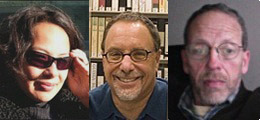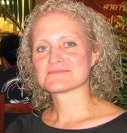This may be the top question I get when I work with library digitization projects. Recently, a seminar was convened to address the broader issue:
Undue Diligence: Seeking Low-risk Strategies for Making Collections of Unpublished Materials More Accessible
OCLC, a nonprofit membership organization of computer, library service and research organizations, organized the seminar and coordinated the effort that resulted in a one page document to help users with a practical approach to selecting collections, making decisions, seeking permissions, recording outcomes, establishing policy and working with future donors: Well-intentioned practice for putting digitized collections of unpublished materials online.
Fairly Used sits down with Ricky Erway and Merrilee Proffitt, Senior Program Officers, OCLC Research to learn more.
Minow: What prompted you to develop the Well-Intentioned Practice Document for libraries and archives?
Proffitt: This is a follow-up to a previous activity we did with institutions to encourage them to digitize more from special collections, and do it at scale. Our original exercise (which resulted in a paper called Shifting Gears) was aimed at getting institutions to refocus from digitizing a few collection high points, to digitizing entire collections, and to do it at scale. To focus more on access and less on preservation. For those institutions who held more modern collections, concern about rights was big stumbling block.
Erway: We had ruled rights issues off-topic for that activity, but now it was time to look at the issue of rights – and to do it from a risk management perspective. I’d like to be clear that the Well-intentioned Practice document was drafted with the help of an advisory group and the speakers of the event you mentioned and had lots of review and reworking by others during and after the event. It is not an OCLC document. It is of, by, and for the community.
Minow: Is there a connection with the Society of American Archivists Orphan Works: Statement of Best Practices? See our interview with Heather Briston on that statement.
Proffitt: OCLC Research and the RLG Partnership actually funded the meetings that led up to the publication of that document, and I was privileged to participate in the discussion and also played a small role in writing the document. I think the documents are very complementary. From my viewpoint, the well intentioned practices can be used at a higher level, to help rule collections in and out of scope for digitization.
Erway: There is still an important role for guidelines (how to determine if something is still in copyright, how to balance the fair use factors, how to locate rights holders…) They should be considered on a case by case basis. It all depends on the nature of the collection and the perceived risk.
Minow: In the suggestions going forward, in working with donors, institutions are suggested to include in the deed of gift that: if content is in the public domain, ensure that no restrictions are placed if content is in the public domain, ensure that no restrictions are placed on it; if donor retains the rights, seek license to digitize the materials for unrestricted access; ensure that nothing will limit or restrict fair use rights . This seems very helpful. Do you have a sense that this is becoming standard in deeds of gift today?
Proffitt: With archival backlogs a growing concern, I think many institutions are rethinking the way they appraise and accession collections, and there is a growing interest in ensuring that collections we do take in can be put to as many uses as possible. Working more closely with donors is a growing trend, I’m happy to say, and I think that’s a good thing.
Minow: Do you think in general that the library and archive community is overly cautious in making their unpublished works available online? Is the intent of this document to help increase the efforts to share works with the public?
Proffitt: I think there are many cases were caution is appropriate. But it’s also important to take risks on behalf of serving scholarship, which is a core mission for most of our institutions. Going back to Shifting Gears, we want the community to find ways to digitize more collections. Assessing risk and consequences for collections that may have items in copyright is part of the toolkit that reasonable archivists should have at their disposal. In the end it comes down to making sound judgments based on the information at hand and I think that librarians and archivists are very capable of making judgments that will benefit scholars and not get their institutions into hot water.
Erway: Sometimes we forget that it is Counsel’s job to assess risk and advise us, but it is our job to make the ultimate decision. We’re encouraging decisions that balance risk with mission.
Minow: Are you aware of any institutions that have been threatened with a lawsuit or asked to take down works that they have digitized?
Erway: In almost any crowd, if you ask for examples of institutions that have been sued for making something accessible online, you are greeted with silence. Or an example that’s not quite on topic. Or a story about a threat that was amicably resolved. Mostly you hear about the effectiveness of gentle wording and generous take-down policies! Or about the person was so thrilled to see his stuff on your site. So if no one is being sued, why do we lose so much sleep over this? Let’s do it with good intentions, but not shirk our responsibilities as caretakers of these collections.
Minow: Where can readers get more information about these issues? This is a softball for you to add the link to the wonderful materials you made available from the seminar!
Erway/Proffitt:
The Well-Intentioned Practice document is at http://www.oclc.org/research/activities/rights/practice.pdf
The information about the Undue Diligence event is at http://www.oclc.org/research/events/2010-03-11.htm
New developments will be tracked on this page
[*] Ricky Erway and Merrliee Proffitt are both Senior Program Officers with OCLC Research.
Mary Minow is Executive Editor of the Stanford Copyright and Fair Use Website.





